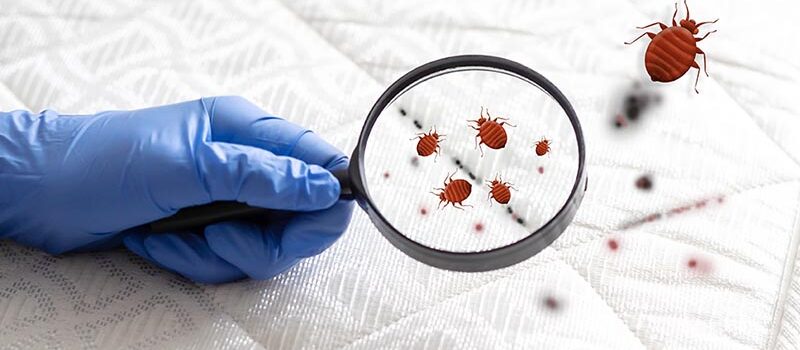How to Check for Bedbugs
Comprehensive Guide on How to Know if you Have Bedbugs in your Home or Holiday Let
Bed bugs are small, elusive pests that can wreak havoc on your sleep and peace of mind. If you suspect that you might have a bed bug infestation, it’s essential to know how to identify them. In this guide, we’ll cover the signs of bed bugs, how to inspect your home, and what steps to take if you find them.
What Are Bed Bugs?
Bed bugs are small, flat insects that feed on the blood of humans and animals. They are typically reddish-brown, about the size of an apple seed, and can easily hide in various places around your home. Bed bugs are most active at night, which makes them particularly difficult to spot.
Signs You Might Have Bed Bugs
1. Bite Marks
One of the first signs that you might have bed bugs is waking up with bite marks. Bed bug bites often appear in clusters or lines on exposed skin, usually on the arms, neck, and face. The bites are typically red, itchy, and can become swollen. However, not everyone reacts to bed bug bites, so the absence of bites doesn’t mean you’re free of these pests.
2. Blood Stains on Bedding
If you notice small red or brown stains on your sheets or pillowcases, it could be a sign of bed bugs. These stains may come from crushed bugs or blood from bites. If you find these stains, it’s a good idea to investigate further.
3. Dark Spots
Bed bugs excrete digested blood, which can appear as dark, small spots on your bedding or mattress. These droppings are typically tiny and resemble pepper flakes. Look closely in seams, folds, and crevices of your mattress and box spring for these signs.
4. Eggs and Eggshells
Bed bug eggs are tiny, about the size of a pinhead, and are usually white or translucent. You might find them in clusters in hiding spots. Eggshells, which are left behind after nymphs hatch, can also be an indication of an infestation.
5. Musty Odor
An unusual, musty smell in your bedroom can be another indication of bed bugs. This odor comes from the scent glands of the bugs, and it may become more pronounced as the infestation grows.
6. Presence of Bed Bugs
Of course, the most definitive way to know if you have bed bugs is to see one. Check your mattress, bed frame, and nearby furniture for the bugs themselves. They often hide during the day in seams, crevices, and cracks. If you see a bug, it’s essential to act quickly.
Where to Look for Bed Bugs
When you’re investigating for bed bugs, you should check several areas in your home:
- Mattresses and Box Springs: Inspect the seams, folds, and any gaps.
- Bed Frames: Look in joints, cracks, and crevices.
- Headboards: Bed bugs often hide behind or under headboards.
- Nearby Furniture: Nightstands, chairs, and other furniture close to the bed should also be examined.
- Walls and Baseboards: Check behind pictures, wallpaper, and in cracks.
- Luggage and Bags: If you’ve traveled recently, bed bugs might hitch a ride in your luggage.
How to Inspect Your Home
- Gather Your Tools: You’ll need a flashlight, a magnifying glass, and possibly a flat-edged tool like a credit card for scraping.
- Start at the Bed: Strip your bed and check the mattress and box spring thoroughly. Use your flashlight to look in every nook and cranny.
- Move to the Furniture: Check other pieces of furniture in the bedroom, especially those close to the bed. Don’t forget about dressers, nightstands, and chairs.
- Inspect Other Rooms: If you suspect a widespread infestation, check other bedrooms and living areas. Bed bugs can travel, so inspect where people spend time.
- Look for Signs: Don’t just look for bugs; check for all the signs mentioned above, including blood spots, dark fecal spots, and eggs.
What to Do If You Find Bed Bugs
1. Confirm the Infestation
Before taking any action, ensure that what you’ve found is indeed bed bugs. If you’re uncertain, consider capturing a specimen in a sealed container and showing it to a pest control professional for identification.
2. Contain the Infestation
If you confirm the presence of bed bugs, it’s crucial to contain the infestation. Isolate infested items, such as bedding and clothing, by placing them in sealed bags. Avoid moving items around your home to prevent spreading the bugs.
3. Clean Thoroughly
Wash all infested bedding and clothing in hot water and dry them on high heat. Vacuum your mattress, bed frame, and surrounding areas, and dispose of the vacuum bag immediately in a sealed plastic bag.
4. Call a Professional
While DIY methods can help manage minor infestations, calling a pest control professional is often necessary for effective eradication. They have the expertise and tools to eliminate bed bugs completely.
Conclusion
Detecting bed bugs early can save you a lot of stress and expense. By knowing the signs and taking proactive measures, you can protect your home from these unwanted pests. If you have tried all the above methods and are still unsure whether you have bedbugs, then book an inspection with us today. Alternatively, if you have found signs of bedbugs it’s important to act quickly before the infestation gets out of control, so contact us to get an estimate and book in your treatment asap.


Leave a Reply